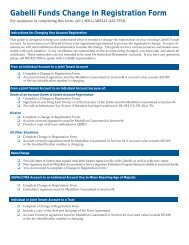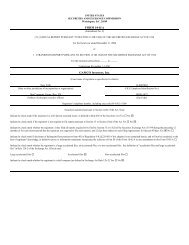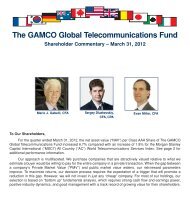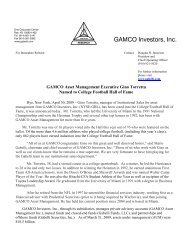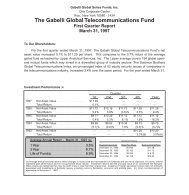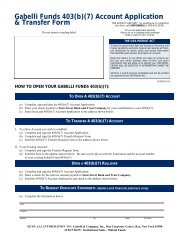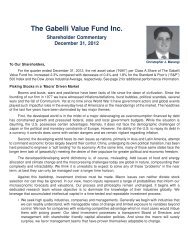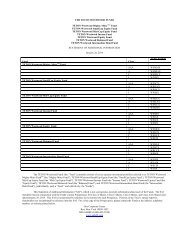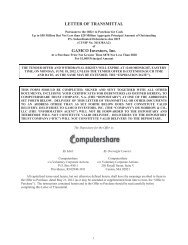Original GBL Prospectus - Gabelli
Original GBL Prospectus - Gabelli
Original GBL Prospectus - Gabelli
Create successful ePaper yourself
Turn your PDF publications into a flip-book with our unique Google optimized e-Paper software.
Competition and Competitors with Greater Resources<br />
The investment management business is intensely competitive with low barriers to entry and is<br />
undergoing substantial consolidation. Many organizations in this industry are attempting to market to and<br />
service the same clients as the Company, not only with mutual fund products and services, but also with a<br />
wide range of other Ñnancial products and services. Many of the Company's competitors have greater<br />
distribution capabilities, oÅer more product lines and services, and may also have a substantially greater<br />
amount of assets under management and Ñnancial resources. These competitors would tend to have a<br />
substantial advantage over the Company during periods when the Company's investment performance is not<br />
strong enough to counter these competitors' greater marketing resources. See ""Business Ì Competition.''<br />
Reliance on Third-Party Distribution Programs<br />
The Company has recently experienced signiÑcant growth in sales of its open-end Mutual Funds through<br />
Third-Party Distribution Programs, most of which is from NTF Programs. Approximately $900 million of the<br />
Company's assets under management in the open-end Mutual Funds as of September 30, 1998 were obtained<br />
through NTF Programs. The cost of participating in Third-Party Distribution Programs is higher than the<br />
Company's direct distribution costs, and there can be no assurance that the cost of Third-Party Distribution<br />
Programs will not increase in the future. Any increase would be likely to have an adverse eÅect on the<br />
Company's proÑt margins and results of operations. In addition, there can be no assurance that the Third-<br />
Party Distribution Programs will continue to distribute the Mutual Funds. At September 30, 1998,<br />
approximately 89% of the NTF Program net assets in the <strong>Gabelli</strong> and <strong>Gabelli</strong> Westwood families of funds are<br />
attributable to two NTF Programs. Further, 89% of the total assets in The Treasurer's Funds are attributable<br />
to one Third-Party Distribution Program. The decision by these Third-Party Distribution Programs to<br />
discontinue distribution of the Mutual Funds could have an adverse eÅect on the Company's growth of assets<br />
under management.<br />
Fee Pressures Could Reduce ProÑt Margins<br />
There has been a trend toward lower fees in some segments of the investment management industry. In<br />
order for the Company to maintain its fee structure in a competitive environment, the Company must be able<br />
to provide clients with investment returns and service that will encourage them to be willing to pay such fees.<br />
Accordingly, there can be no assurance that the Company will be able to maintain its current fee structure.<br />
Fee reductions on existing or future new business could have an adverse impact on the Company's proÑt<br />
margins and results of operations.<br />
Possibility of Losses Associated with Underwriting, Trading and Market-Making Activities<br />
The Company's underwriting, trading and market-making activities are primarily conducted through its<br />
subsidiary, <strong>Gabelli</strong> & Company, both as principal and agent. Such activities subject the Company's capital to<br />
signiÑcant risks of loss. The risks of loss include those resulting from ownership of securities, extension of<br />
credit, leverage, liquidity, counterparty failure to meet commitments, client fraud, employee errors,<br />
misconduct and fraud (including unauthorized transactions by traders), failures in connection with the<br />
processing of securities transactions and litigation. The Company has procedures and internal controls to<br />
address such risks but there can be no assurance that these procedures and controls will prevent losses from<br />
occurring.<br />
Dependence on Information Systems<br />
The Company operates in an industry that is highly dependent on its information systems and technology.<br />
The Company outsources a signiÑcant portion of its information systems operations to third parties who are<br />
responsible for providing the management, maintenance and updating of such systems. There can be no<br />
assurance, however, that the Company's information systems and technology will continue to be able to<br />
accommodate the Company's growth, or that the cost of maintaining such outsourcing arrangements will not<br />
increase from its current level. Such a failure to accommodate growth, or an increase in costs related to these<br />
information systems, could have a material adverse eÅect on the Company.<br />
15




